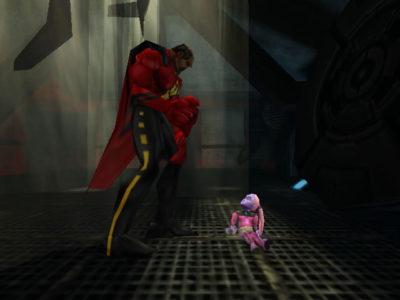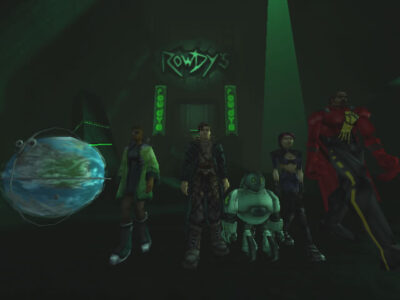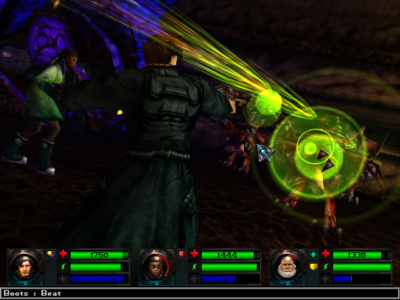
Anachronox
Written by: Stoo
Date posted: June 9, 2005
- Genre: RPG
- Developed by: Ion Storm
- Published by: Eidos
- Year released: 2001
- Our score: 10
You may have heard of Texas-based developers’ studio Ion Storm, who produced a few high-profile titles over their 9 years in business. With the help of some former Looking Glass Studios employees, their Austin branch is known for the classic Deus Ex, as well as its sequel and Thief Deadly Shadows, which weren’t exactly classics themselves but still half decent. The other branch hailed from Dallas, and is mostly known for one of PC gaming’s most high-profile flops – the over-hyped and pretty mediocre Daikatana. However they did also produce one more title, the RPG known as Anachronox. Like its ill-fated stable-mate, it suffered delays (although not quite as severe) and was commercially unsuccessful. However, unlike Daikatana it was a pretty great game.
So then, Anachronox represents the latest success in my forays into cheap games on eBay. Rather than making a half-hearted attempt to disguise my views, look impartial and save a final verdict for the end of the review, I’m just going to go and say it’s a classic. Seriously, it’s a pretty unique treasure within the realm of PC gaming. Still, I’ve got to attempt to justify that view. Which means another thousand words or so of rambling, lucky reader!
First off, I’ll give you a quick and handy overview: Take Final Fantasy VII. Power it with the Quake II engine. Add a sense of humour. Replace spiky-haired swordsmen with a motely crew of unlikely heroes. Remove about 70% of the combat. That should provide a rough image; it’s an attempt to bring elements of console-RPG style gaming to the PC world, one that is normally more dominated by Baldur’s Gate or Dungeon-Master style titles.
The game starts on the planet Anachronox itself, a city-world built by long-gone aliens, and now inhabited by humans and other races. It’s not an especially pleasant place, in fact it’s a bit of a dump. There are decent neighbourhoods for the wealthy or lucky, but much of the planet is a warren-like world of grimy tunnels, metal walls and neon lighting, home to low-lifes, crooks and scoundrels.
Living here is the game’s central character, Sylvester “Sly” Boots, part roguish anti-hero, part jerk. Although a private detective by trade, Sly has not been especially successful lately and has been out of work for a while. He’s broke, drinks too much and unfortunately owes gangsters money. In fact, the game starts with Boots being beaten up by a sharp-suited thug and then bodily thrown out of his office window. Picking himself up and brushing broken glass out of his hair, Boots realises he needs to earn some cash, somehow. A local collector needs an escort into the tunnels beneath the city to search for rare magical artefacts, Boots decides bodyguard work is better than no work at all, and so begins a chain of events that somehow, miraculously makes a hero out of Sly the loser. He might even save the universe.
Of course, saving the universe could be a terrible cliche. Not, however, if that sense of humour I mentioned is present. This isn’t a full-on comedy game, mind you, and isn’t aiming for a laugh a minute. I’m not sure we’d even want that in a game. It does, however, have a good appreciation for absurdity, from which comes much of its unique character. Humour thus comes though the unlikely situations you find yourself in and the quirky people you meet, be they integral to the story or some unimportant guy behind a bar. It’s an outlandish sci-fi universe that starts off a bit blade-runner-ish but takes several turns for the imaginatively wacky.
Apart from Boots, there are six other characters who join him, who are a pretty eclectic bunch. There’s his former assistant Stiletto, who gave up that line of work and took up being a leather clad assassin instead. Also grumbly old Grumpos, with a beard down to his knees, and Paco the depressed eight-foot superhero. Best of the bunch tho, is a whole bloody planet. No, really. Democratus, planet of the bureaucrats, is shrunk down to human size, floating around next to you. The interactions between this team, and their development as the game progresses, is one of the key selling points. Check out the character guide (link to the left) for more details.
As well as some seriously high-quality voice-acting, one nifty feature that helps bring these people to life is a tweak to the engine to provide facial expressions. They can smile, raise an eyebrow, look scared and so on. It’s a useful feature that is only now becoming more commonplace, with the coming of powerful engines behind games like Half-Life 2.
While on a graphics sideline I should also make it clear that all the cinematic scenes used to help propel the story are done ‘in-engine’. The benefit of this is, a smooth transition from action under your control, to a cutscene for dramatic, comedic or exposition purposes, and then back to your control. You don’t get the same jarring feeling of being yanked out of the game-world into something else, that you might get with pre-rendered scenes. The cinematics are very well written, designed and directed, and thus genuinely enjoyable to watch, even using a 3D engine that was already considered dated back in 2001. In fact after the game was released, the cutscenes were pasted together into a movie – take a look here if you’re interested.
Anyway, with up to three of the team under your control at any time, you guide them across several different worlds. Again, a lot of imagination was put in here. The planet Anachronox itself does actually get a little dull after a while – grey grimy corridors can only hold your attention for so long – but there are some more colourful examples. For example the world of Haephestus, at the heart of which lies a mine in a volcano searching for a magical substance known as Mystech. Next to this is an abbey full of monks pondering the mysteries of Mystech, but these guys have realised that there is money to be made in such a fantastic item. So, around the mine and abbey has grown a horrendous tourist trap pandering to those seeking to obtain such treasures. Small bars jostle with arcades and monks selling Mystech trinkets to visitors, whilst piped easy-listening music tries and fails to create an atmosphere completely at odds with the lava below. It’s all just horribly tacky, and thus highly entertaining.
Even better, later on you find yourself stuck on a mighty warship owned by comic-book villain Rictus. I mean, a comic book villain in universe where such villains and heroes really exist (from the planet Krapton, no less). So he’s aided by implausible henchmen such as pint-sized wrestlers and laser-armed slugs, whilst a narrating voice describes events in a highly dramatic fashion, like something from a 1960s Spiderman comic. When you finally reach Rictus he solemnly declares… “I shall kill you…. with DEATH”. It’s the way Anachronox pokes fun like this that makes it so likeable.
Throughout the game you have a ‘main quest’ to follow, which begins with a Mystech hunt and takes you back and forth across these worlds. There are also numerous side-quests which can produce rewards such as weapons and cash. To find these, you must question everyone you meet, and explore every nook and cranny, in what is a fairly densely packed game. There are hundreds of people to meet, some with quests, others with hints, others just there to chat to. While in truth they’re just standing around or roaming aimlessly, same as in a hundred other such games, Anachronox does a decent job of creating the illusion of a real living world (or worlds). That’s always useful in creating a sense of immersion in the world before you.
If you wish only to dash from one primary objective to the next you miss out on much of what the game has to offer, both in terms of upgrades and entertainment. It often pays, for example, to return to a location you visit earlier to see if merchants have anything new on offer. Also you might want to revisit with different team members to see if people have anything to say specifically to them, or to use their skills to access something previously unreachable. My one real gripe here is, constantly retracing your steps can get a little tedious; for example foot slogging across an entire area just to look for one little change. This was at least partially fixed in a patch, which adds taxis to the planet Anachronox itself.
Combat meanwhile should be instantly familiar to anyone who’s played the likes of Final Fantasy, Chrono Trigger or any other such console RPG. It’s a kind of hybrid of the traditional turn-based and real-time systems PC that gamers will know. Each character can take an action every ten seconds or so, with the wait until they are next available shown as a timer bar filling up. When ready, then can make a regular attack, use a special power, or cast a spell. This accomplished, that character must wait until their timer has filled up once more before taking another action. Computer-controlled enemies meanwhile are bound by the same rule.
The powers have themes suiting their casting character; the planet lets rip with orbiting laser satellites, while the scientist has a forcefield and the superhero pounds the ground with his fists. This normally involves plenty of over-the top special effects, panning cameras and a lightshow; just like you’d expect in a console title. Characters leaping into the air, explosions going off left right and centre, beams of energy and so on. You might know the drill.
Magic meanwhile takes place via the aforementioned Mystech. Equipping various pieces of this enables spells in one of seven realms – fire, poison, insanity etc. Even better, you later on gain the ability to build your own Mystechs, with custom power levels and spell effects. Just to keep things on the slightly improbable side, this involve gathering coloured beetles to plug into a host module. Again, when spells are cast you can count on technicolour effects, getting fancier with more powerful versions. Humble fireballs aren’t enough, we need swirly blasts and beams, giant blue cubes of ice, and evil black jellyfish monsters shooting tentacles into someone’s head. Of course.
I should point out, however, that there isn’t a vast amount of fighting in this game. Certainly not as much as you’d expect from Final Fantasy. Don’t get me wrong, there are a number of dungeon-hack type areas where you’ll have plenty of nasty monsters to carve up. However, there are also many lengthy sections with no combat whatsoever. Sly even gets to do some detective work on a few occasions. One sequence of events has you investigating a theft on the mine planet, another trying to determine which way the bureaucrats will vote on Democratus. In fact, it feels more like an adventure title at times.
Even out of combat, your team has unique skills to help you out. Each of these is implemented in a little 30-second minigame, to determine if your attempt is successful or not. Boots is your man to pick a lock, for example, and this is represented by a game of warmer-colder where you try to guess the positions of the tumblers. Meanwhile the scientist must match up a sequence of colour and symbol tiles to successfully analyse a blueprint. Best of the lot perhaps, is the tractor beam used by the miniature planet to grab otherwise unreachable objects. When you deploy this, the ruling council of the planet calls a meeting, has a big argument and tries to cancel the beam. So you play a little game of whack-a-mole, making councillors sit down before they can rise from their seats and raise a complaint.
If you’re thinking “whaaat?” at that, don’t worry. It’ll make more sense when you see it in action. Throughout the game there are more of these features that make it so entertaining. My top recommendation is taking Boots down to the super-seedy red light district on an orbital station, where in another mini-game you can make him dance at a gay club for money. How many other games would try pulling something like that? Anachronox doesn’t just have solid gameplay, it has character. It actually wants to be something different from just another midly diverting adventure, or Mighty Quest to Save the Universe. That’s what fans love it for.
Usually at this point in a positive review I, in my methodical and formulaic way, try and draw up a collection of factors that aren’t so good in a game. In this case, at least, there’s really nothing broken. Technically speaking it was dated even for its time, but the art and design is good enough for this to be rarely off putting, unless you’re a technology snob. More quick-travel options to reduce backtracking is the only improvement I’d really call for. Oh, and it had some problems with bugs upon first release, but unofficial patches (in fact written by one of the developers in his spare time) have fixed the matter. Some might say the combat is too easy, but then as I’ve tried to explain this game is not about the hack-and-slash. It’s a combination of RPG statistics and action with adventure-game puzzle-solving, in which combat is just one element. There are plenty of other RPGs which feature stacks of monsters to kill, but few offer the engaging characters, events and humour blended together for an excellent story.
There is maybe one problem. Intending this to be just part one of a greater story, Ion Storm had Anachronox finish in very much a “to be continued” situation. Except, the game sadly failed to shift copies and Ion Storm closed down leaving publishers Eidos with the rights. With Eidos apparently completely disinterested in making use of their property, or turning it over to any of the former developers, the chances of a sequel currently seem very slim indeed. So that’s the biggest let-down, knowing I probably won’t get a chance to see what happens next to my favourite bunch of unlikely heroes.
That can hardly be considered a slur on the game itself, though. All in all it comes with top FFG recommendations. Those of you who enjoy console-style RPGs, this is one of the few PC games that operates to a similar framework. If you don’t then, well, this has a completely different personality to the likes of Final Fantasy anyway, and you may well enjoy the storytelling even if the combat doesn’t float your boat. I won’t get into directly rating this against Morrowind or other classics from the more traditional RPG stables; they might fall under the same general header but are really aiming for a different kind of gaming experience. So Anachronox isn’t their superior, but it is a highly enjoyable and unique alternative.





 Posts
Posts